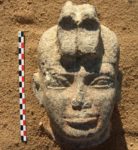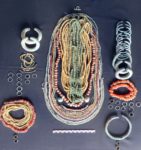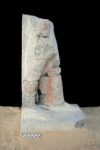 The head from a statue of a Kushite ruler discovered in 2008 at the site of the Temple of Amun in, Dangeil, Sudan, has been identified as that of Aspelta, the king of Kush who reigned from 593 B.C. to 568 B.C. Archaeologists thought the head might be that of Aspelta based solely on a comparison between its features and those of other statues known to depict the Kushite king, but his identity could only be confirmed when fragments of the statue containing a hieroglyphic inscription were discovered during the 2016 and 2017 dig seasons. The inscription, now puzzled back together, describes Aspelta as “King of Upper and Lower Egypt,” “Beloved of Re’-Harakhty” (a Kushite version of the Egyptian sun god “Re”) and as having been “given all life, stability and dominion forever.”
The head from a statue of a Kushite ruler discovered in 2008 at the site of the Temple of Amun in, Dangeil, Sudan, has been identified as that of Aspelta, the king of Kush who reigned from 593 B.C. to 568 B.C. Archaeologists thought the head might be that of Aspelta based solely on a comparison between its features and those of other statues known to depict the Kushite king, but his identity could only be confirmed when fragments of the statue containing a hieroglyphic inscription were discovered during the 2016 and 2017 dig seasons. The inscription, now puzzled back together, describes Aspelta as “King of Upper and Lower Egypt,” “Beloved of Re’-Harakhty” (a Kushite version of the Egyptian sun god “Re”) and as having been “given all life, stability and dominion forever.”
 He was not, incidentally, king of Upper and Lower Egypt or any other part of it, for that matter. Some of his distant predecessors were, but by the time Aspelta took the throne, the Kushite monarchs no longer ruled Egypt. The last Kushite king of Egypt was Tanwetamani who ruled ca. 664–653 B.C. and lost control of the ancient land to the north more than 50 years before Aspelta’s reign. The title is vestigial, a carryover of former glory rather than any stubborn claim to the throne of Egypt.
He was not, incidentally, king of Upper and Lower Egypt or any other part of it, for that matter. Some of his distant predecessors were, but by the time Aspelta took the throne, the Kushite monarchs no longer ruled Egypt. The last Kushite king of Egypt was Tanwetamani who ruled ca. 664–653 B.C. and lost control of the ancient land to the north more than 50 years before Aspelta’s reign. The title is vestigial, a carryover of former glory rather than any stubborn claim to the throne of Egypt.
 The Temple of Amun where the statue pieces were found is about 2,000 years old. The statue of Aspelta is believed to have been carved during his lifetime circa 2,600 years ago. It was displayed in the temple long after his death for religious reasons.
The Temple of Amun where the statue pieces were found is about 2,000 years old. The statue of Aspelta is believed to have been carved during his lifetime circa 2,600 years ago. It was displayed in the temple long after his death for religious reasons.
“Statues might be displayed in temples, particularly the forecourts of temples, after the reigns of the kings, as they may have served as intermediaries between the people and the gods in popular religion,” [excavation co-director Julie] Anderson told Live Science.
 The temple remained in active use until the early 4th century. Kush collapsed shortly thereafter and that was the end of the temple’s ancient prominence. It retained enough significance, however, that in the Middle Ages the ruined temple was repurposed for use as a burial ground for wealthy people, even though the area was firmly Christian by then. The last two field seasons have discovered eight graves dating to
The temple remained in active use until the early 4th century. Kush collapsed shortly thereafter and that was the end of the temple’s ancient prominence. It retained enough significance, however, that in the Middle Ages the ruined temple was repurposed for use as a burial ground for wealthy people, even though the area was firmly Christian by then. The last two field seasons have discovered eight graves dating to  between the late 11th and early 13th centuries containing skeletal remains of adult women and one juvenile. The tombs were rich with grave goods, among them elaborate bead necklaces, bead belts, rings, bracelets and anklets. More than 18,500 beads and 70 copper bracelets in total were found in the eight graves.
between the late 11th and early 13th centuries containing skeletal remains of adult women and one juvenile. The tombs were rich with grave goods, among them elaborate bead necklaces, bead belts, rings, bracelets and anklets. More than 18,500 beads and 70 copper bracelets in total were found in the eight graves.
 There are no indicators of who these people might have been. The jewelry suggests they were rich, members of the elite, but there are no names or any other information that might explain who they were or why they buried in the remains of an ancient temple dedicated to a sun god.
There are no indicators of who these people might have been. The jewelry suggests they were rich, members of the elite, but there are no names or any other information that might explain who they were or why they buried in the remains of an ancient temple dedicated to a sun god.
 Meanwhile, the statue of Aspelta is still being pieced together. The Berber-Abidiya Project team, a collaborative effort of archaeologists from the British Museum and the Sudanese National Corporation for Antiquities and Museums (NCAM) are hoping to discover more fragments to aid in the reconstruction. Once more of the work is done, they’ll be able to tell how large a statue it was. Right now it looks to be about half life-size.
Meanwhile, the statue of Aspelta is still being pieced together. The Berber-Abidiya Project team, a collaborative effort of archaeologists from the British Museum and the Sudanese National Corporation for Antiquities and Museums (NCAM) are hoping to discover more fragments to aid in the reconstruction. Once more of the work is done, they’ll be able to tell how large a statue it was. Right now it looks to be about half life-size.
Named after the region, the Berber-Abidiya Project aims to conserve the temple and its artifacts in situ so it can be converted into a museum and archaeological park. This will bring much-needed tourist attention to an area where cultural patrimony is in danger from development, road construction, agriculture and irrigation installations.
Very interesting find. But unfortunately much need tourism will not come to the area until the security situation is drasticly improved.
Tidbit– in modern Hebrew the slang or not politically correct word for an African/ black person is “kushii”.
Discover Sudan, Susie!
———
“During the New Kingdom of Egypt, Nubia (Kush) was an Egyptian colony, from the 16th century BC governed by an Egyptian Viceroy of Kush. With the disintegration of the New Kingdom around 1070 BC, Kush became an independent kingdom centered at Napata in modern northern Sudan. […] Kashta’s successor Piye seized control of Lower Egypt around 727 BC, creating the Twenty-fifth dynasty of Egypt. This continued until about 671 BC when they were deposed by the Neo-Assyrian Empire. […] The Assyrians, who had a military presence in the north, then sent a large army southwards. Tantamani was routed, and the Assyrian army sacked Thebes to such an extent it never truly recovered. Tantamani was chased back to Nubia, and never threatened the Assyrian Empire again. A native Egyptian ruler, Psammetichus I, was placed on the throne, as a vassal of Ashurbanipal. […] In 592 BC, Kush was invaded by an Egyptian military premptive strike initiated by Pharaoh Psamtik II (Psammetichus II) and Aspelta moved the capital to Meroë, considerably farther south than Napata, possibly in 591 BC. It is also possible that Meroë had always been the Kushite capital.”
A graffito inscribed in Greek on the left leg of the colossal seated statue of Ramesses II, on the south side of the entrance to the temple of Abu Simbel, records that: “When King Psammetichus [II] came to Elephantine, this was written by those who sailed with Psammetichus the son of Theocles, and they came beyond Kerkis as far as the river permits. Those who spoke foreign tongues [Greek and Carians who also scratched their names on the monument] were led by Potasimto, the Egyptians by Amasis.”
———
I have to admit, however, that I am still trying to figure out, how “Dangeil” (18° 08′ 00″ N, 33° 59′ 00″ E) fits into all of this. Napata seems to be at 18.53°N 31.84°E (Meroë, but obviously ‘Napata’ is not ‘Meroë’), also cf.: https://discoversudan.de/en/sudan/locations :confused:
Confront your cheating spouse with evidence, I was able to spy on my cheating ex phone without finding out…..it really helped me.. contact hotcyberlord at gmail dot com or call and text +15402277725 for spying and hacking social networks, school servers, icloud and much more, viber chats hack,retrieving deleted texts of any kind. Facebook messages and yahoo messenger, calls log and spy call recording, monitoring SMS text messages remotely, cell phone GPS location tracking, spy on Whats app Messages.
Email: hotcyberlord at gmail dot com
text num:+15402277725
tell him jane referred you.